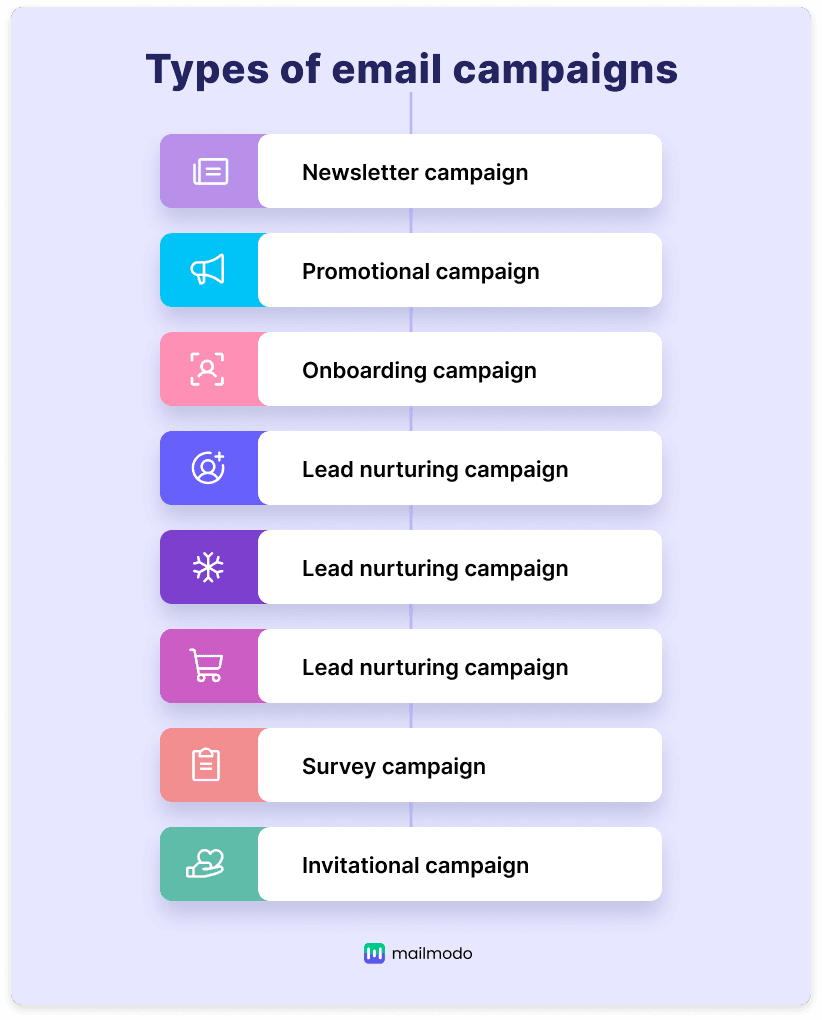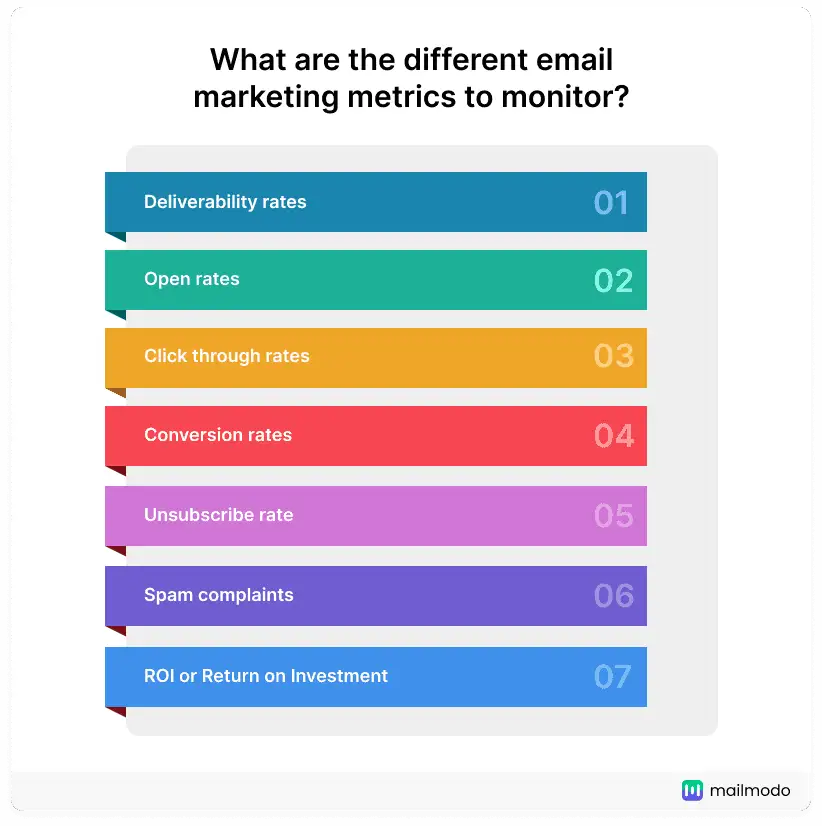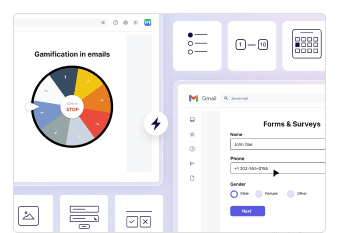Email marketing is the practice of delivering commercial messages using email to target potential customers for elevating sales. Out of the many reasons to adopt email marketing, the foremost is that it is a fairly simple, low-cost, and highly efficient means to exchange important information with your users. This article will be your go-to guide for email marketing, where we exhaustively discuss every aspect of it.
Table of contents
What is email marketing?
Email marketing is a direct marketing channel that uses emails to promote your business's products and services and informs customers about your latest items, offers, or news. It is critical in increasing brand awareness, driving engagement, nurturing leads, or making a sale.
What are the benefits of email marketing?
Emails are not just alive; they thrive on the many benefits they deliver. The major benefits that make email every marketer’s favorite tool are as follows:
1. Budget-friendly marketing channel
For each dollar spent on email marketing, you can get an ROI of 51.52 USD, as per the DMA 2021 report. Since there are no advertisement fees, printing costs, or media space costs, Email marketing campaigns can be much less expensive and more rewarding than other types of marketing.
2. Increased brand awareness
According to Statista, roughly 306.4 billion emails were sent and received daily in 2020. This number is expected to rise to over 376.4 billion emails by 2025. Hence emails have played a huge role in building brand communication channels and spreading awareness about their beliefs, mission, products, services, etc., and will continue to do so in the coming days.
3. Emails are (almost) universal
According to a survey, 93.6% of US customers between the ages of 25-44 years use email, which in itself is a huge number to engage with for different purposes.
4. Better customer relationship
It is an excellent way to establish personal relationships with existing and future customers. Consumer knowledge of your business, goods, and services is reinforced each time they receive your mail.
5. Easy monitoring of campaigns
Performance measurements and statistics are available for each email sent. This data is crucial for determining the effectiveness and what needs to be changed.
6. Your email audience is more permanent
When you make an email account, it becomes your property. But, unlike many other social handles whose real control is with the provider, emails have the security where no one can cease or delete your content unless it’s spam or illegal.
💡 Related guide: 13 Benefits of Email Marketing For Businesses in 2023
Types of email campaigns
When you collectively look at all your emails, they can be vastly categorized into many different email campaigns depending on your motive behind them.

Let’s look at the types of email marketing campaigns that can elevate the growth of your business.
1. Newsletter campaign
Newsletter campaigns are used to maintain regular communication between you and your subscribers. It keeps them updated on the latest product and services and even helps educate and entertain them.
2. Promotional campaign
Promotional campaigns relay specific communication or sales objectives to entice a purchase, attract customers, and increase brand awareness.
3. Onboarding campaign
Onboarding email campaigns help build familiarity with new subscribers and educate them about your brand.
4. Lead nurturing campaign
These emails help to build long-term relationships with your subscribers by providing them with relevant and worthwhile content and warming them up until they are ready for purchase.
5. Seasonal campaign
This email sequence is exclusively sent during the ongoing holiday or festival season, like New Year's, Christmas, etc., to inform your subscribers about sales and offers.
6. Abandoned cart campaign
Cart abandonment emails are follow-up emails triggered by a user’s activity. These emails aim to remind and encourage a subscriber to complete a purchase.
7. Survey campaign
These emails are sent to your subscribers to collect data, feedback, and suggestions to help enhance and manage your business.
8. Invitation campaign
An invitational campaign aims to make an experience available to users, like events, conferences, webinars, etc., and encourage them to engage, interact and participate in it.
Other types of email campaigns
Here are some other types of emails you should know about:
- Transactional campaign
Transactional emails contain information that needs to be delivered to a candidate due to their action on a website.
- Drip campaign
A drip campaign is a triggered series of automatic emails sent to specified email subscribers to achieve a particular objective on a predefined schedule.
- Bulk email campaign
Send marketing emails simultaneously to a diverse category is a bulk email campaign. Check out Mailmodo's bulk email service for managed email deliverability and scalable infrastructure.
- Cold email campaign
Cold email is a one-to-one, customized email aimed at a particular user. Instead of promoting a product or a service to the masses, its purpose is to get into a business conversation with that person. This is done to get new customers and enlarge your email list.
So now that you don’t doubt the impact of email marketing strategy and its necessity, let’s understand the most important thing about email marketing.
What is an email client?
An email client is a software or app that lets you send or receive emails. They configure with your inbox providers to help you access emails. It enables users to compose and organize emails efficiently. Email clients can also provide additional features like spam filtering, message threading, and scheduling. Popular email clients include Gmail, Outlook, Thunderbird, and Apple Mail.
ESPs or email marketing softwares differ from email clients. ESPs often use email clients’ services to enable email marketing software to send emails.
What is an email marketing software?
An email marketing software will let you automate email communication to customers, prospects, and businesses. The software helps increase email marketing efficiency, monitor email campaign effectiveness, and manage the complete mailing lists.
These softwares or tools are also known as email marketing service providers, ESP, email marketing services, and other prevalent terms.
Email service providers are technology firms that create email lists and send emails conveniently to people. Broadly known ESPs are Mailchimp, Mailmodo, ActiveCampaign, Gmail, Yahoo, Zoho, etc.
Now that we understand what email marketing softwares and clients are let’s discuss how to do you choose the right software for your business.
How to choose the right email software for your business?
Look for the following things while deciding the best email software for your campaigns:
- Simple to use
That shouldn’t consume a lot of your time. To design good quality emails, they must have simple elements like drag and drop, pre-made templates, etc. Look for a library of email templates that serve various purposes, from announcements, promotions, newsletters, and more.
- Email list expansion
Your software must organically grow your platform by providing lead magnets, sign-up forms, a follow-up system, etc.
- Easy personalization
You should be able to thoroughly divide your section and customize as many details as possible. Look for a WYSIWYG editor that perfectly works, so you can just drag and drop pieces within the templates like hero images, text, CTA buttons, dividers, and spacers.
- Email testing
In a standard test flow, you’d either need to send an email from your test case or receive an email prompted by some action in your testing. For example, if your email appears to activate a spam filter, it will send you further details.
- Email responsiveness
Your software should learn and advance itself with time. You need to ensure that your email marketing software automatically optimizes your email campaigns to different mobile devices and provides you with various mobile-friendly templates.
💡 Related guide: How to Make Your Email Responsive For Mobile Devices
- Analytics
Email analytics has to be a core ground for selecting your email marketing software. The software must provide detailed numerical analysis and an uncomplicated view of data.
Some of the best email marketing software are Mailmodo, SendinBlue, HubSpot, Constant Contact, Drip, ConvertKit, and Mailchimp.
Now that you have email marketing software, you can create your email.
Step-by-step guide to sending your first email campaign
This section will help you to start your email marketing journey as a beginner.
1. Build your email list
An email list is a list of email addresses to whom you will send the emails. Building an email list is essential for any brand. This means folks who want to hear from your brand because they have a certain brand affinity. There are various methods for building an email list, such as:
- Include a prominent sign-up button
Rarely do people come to a website only to sign-up. Therefore once your content has provided them value and they are ready to be subscribers, don’t make them search for the sign-up key.
- Exchange email addresses
When meeting people, hand out your business card with your email id.
- Host events and webinars
Use this chance to get an email ID while candidates register for your event.
- Lead magnets and giveaways
You can ask people to provide their mail ids in exchange for rewards. These rewards don’t have to be expensive as they can be relevant and valuable, like whitepapers, ebooks, PDFs, audiobooks, etc.
- Use blogs
Your blogs will cover various topics and help build personal relationships. Follow up blog content by asking the reader for an email id to stay updated about updates.
- Build an online community
Community members will forward your content to like-minded people and help get new people involved in that community. As a result, your list will grow along with your community.
- Use social media to promote your newsletter
Social media promotion is a great way to catch the most loyal customers. Hence, capitalize on social signals to build email lists.
💡 Related guide: How to Increase Email List Subscribers
2. Craft your email copy
That is a very broad spectrum and depends on the objective of your email marketing. You must:
Provide valuable content and make it interactive for your subscribers.
Write subject lines that are relevant and catchy to get more open rates
Proofread your emails before sending them and taking feedback every few months.
Send new campaigns regularly and add a call to action.
Analyze and stick to what works, as this may be a trial and error method, but continue using it once you realize what works best for you.
3. Design your email
When using good software, you’ll have pre-made templates to design emails. Many software mostly contains drag-and-drop editors, which can customize the template. Some providers let you merge different template elements to create one for your own.
Add your flavors, and you’re good to go.
Now that your email is ready, you next need to send emails to your subscribers.
4. Schedule and send your campaign
The next step is to schedule sending. Choose the best time to send emails. Depending on time zones, holidays, and other marketing factors, send out your campaigns when your users want to read them.
Now that you have sent your first campaign, you might wonder what to do next. Well, this is precisely the point where you improve your campaigns by evaluating the performance of your past campaign.
5. Monitor performance with analytics
To be a good email marketer, you must improve and learn from the performance of your past campaigns. To do this, you will have to understand the email marketing metrics that can evaluate and measure the efficacy of an email marketing campaign.
6. Give readers choice to opt in or out
Once people subscribe to your emails, you must ascertain their permission to send emails and verify the email ids they have provided. For this, you will have to use the most suitable opt-in method.
Opt-in methods authenticate the email address and recheck the user's intention using links, OTPs, and other tokens. The most popular opt-in forms are either single or double-staged as follows.
| Single opt-in | Double opt-in |
|---|---|
| Your users must enter their email addresses only once into a website to become a member in a single opt-in. | In double opt-in, you must go through two-tier verification, where you become an official member after subscribing to the website from your inbox. |
Single opt-in is easier, while double opt-in shows more commitment. So, it is your call which one you’d prefer. But no matter what tricks and hacks you use to grow your email list, never buy it!
What are the different email marketing metrics to monitor?
Below is a list of the most important metrics you need to track and monitor.

1. Deliverability rates
Deliverability rates inform you how many emails have been delivered to your subscriber’s inbox and not marked as spam.
2. Open rates
The email open rate is the percentage of subscribers who open a separate email from your total number of subscribers.
3. Click-through rates
Email click rate calculates how many individuals clicked on a hyperlink, CTA, or image in an email marketing campaign.
4. Bounce rates
The email bounce rate is the number of emails that do not reach the destination address and thus are reverted to the sender.
5. Conversion rate
Email conversions are the percentage of customers who execute a target action after reading your email. This is an important metric for most marketers as it demonstrates your campaign's success and measures your ROI or returns on investment.
6. Unsubscribe rate
The number of recipients unsubscribed from your email lists is known as the unsubscribe rate. This involves all recipients who use the standard unsubscribe link in the email footer and those who use the list-unsubscribe feature in the inbox to unsubscribe.
7. Spam complaints
When a person marks your email as spam, a complaint is registered with the ISP. Such reports will impact your reputation and your next campaigns’ deliverability rate. If you recognize a pattern, thoroughly check for mistakes through the spam filter policy.
8. ROI or Return on Investment
It is your email campaigns’ average profit margin. The total revenue from emails is divided by the total email marketing service expenditure to get this number.
As you might have recognized, the email deliverability rate is one of the most important metrics on which the entire email campaign depends.
💡 Related guide: Email Deliverability: A Complete Guide For Marketers
How to create an effective email marketing strategy
A smart and fruitful email marketing strategy focuses on the following:
Defining the goals and objectives of your campaigns.
Target audiences for your email marketing campaigns.
SWOT analysis of your past email campaigns.
Identifying the type of emails and the email cadence.
Leveraging automation for better behavioral targeting and customer segmentation.
💡 Related guide: 12 Email Marketing Strategies in 2023
Email marketing tools to send better email campaigns
We have covered most of the ground for sending a good email campaign with email analytics. Let’s check out useful tools to help you create and send better campaigns.
1. Email testing tools
These are like software that ensures your emails display properly on your receiver’s devices. In addition, these tools show email previews and spam tests and help with email validations. A few popular HTML validations and email testing tools are Litmus, Mailtrap, and Email on Acid.
2. Email deliverability tools
The email delivery tool shows you the IP of your email server, the information about your SPF & DKIM setup, the evaluation of the content of your message in the "eyes’’ of spam filters, your possible appearance on any blacklists, and the general likelihood of inbox access. A few examples are SendForensics, Glockapps, and MxToolbox.
3. Email verification tools
Tools for email verification confirm that emails are deliverable to minimize bounces and enhance the efficiency of email marketing and outreach campaigns. In combination, email verification tools can help clean bots and inactive accounts from your mailing list to ensure only genuine active recipients receive your business emails and avoid spam.
Email verification tools include Zero Bounce, Bouncer, The Checker, and Debounce.
Now you have learned the tricks of the trade. Let’s see how you can improve your email campaigns to take your game up.
Email best practices to follow for good results
The following suggestions are built on the best practices across industries and use cases. Try to teach these pointers to send out more effective, targeted, and meaningful email campaigns.
Make a responsive email design.
Perform A/B testing on subject lines, email copy, and CTA.
Follow guidelines to improve deliverability.
Do not buy an email list.
Respect your customers.
Make your emails accessible for every user.
This should help you build better connections with your recipients. And as you keep sending out campaigns, do not forget to look at all the emerging trends and practices in email marketing.
Email marketing course to become an expert
Whether you're a marketer looking to expand your skills or a business owner seeking to improve your marketing efforts, an email marketing course can be a great way to gain the knowledge and skills necessary to create effective email campaigns.
You can enrol in the email marketing course "Email Masterclass by Mailmodo" designed to make you an email expert.
Chapter 1: Introduction to Email Marketing
Chapter 2: Understanding Email Analytics & Metrics
Chapter 3: Getting Email Deliverability Right
Chapter 4: How to Segment Your Email List
Chapter 5: The Art of Writing a Good Email Copy
Chapter 6: Fundamentals of Email Design
Chapter 7: Using AMP Emails to boost conversion
Become an email marketing expert in 90 mins
On-demand certification to master email marketing
Future of email marketing
Two major trends have hit the email marketing world like a storm - AI and interactive emails.
AI has taken over many email marketing ops like subject line generation, email copywriting, send time optimization, personalization, etc.
💡 Related guide: 8 Ways to Use AI in Email Marketing in 2023
The next revolutionary trend is interactive emails. Sending dynamic and actionable emails, where the user doesn’t have to jump webpages to take action. This is changing the way email marketing works. It has led to a new email metric called the ‘Submission rate’, which represents the number of forms or interactions done by a prospect inside the email.
This became easy to incorporate into email marketing strategy when Google released AMP for email in 2019.
So how does this help you as an email marketer?
How can AMP emails help you boost your email marketing ROI
When you want to go that extra step and provide your users with a website or app-like experience, it’s time to start sending AMP emails. They differ from regular email in the following ways:
Content can be updated in real-time with AMP for email, ensuring audiences have the most up-to-date details.
Interactive emails help engage and increase email conversions by enabling users to schedule meetings, add forms, purchase from abandoned carts, etc., inside the email.
AMP emails have an HTML fallback version showing if the receiver uses an email client without AMP email support.
As per Google, no third-party ad features would be used in AMP emails. It is a positive move to ensure that email browsing is safe and has no privacy or security issues.
These major technological and functional differences between AMP and standard emails, but do AMP email conversion metrics also differ?
Do AMP emails provide better email conversion?
Short answer: Yes.
We’ve conducted numerous case studies where we discovered that AMP emails effectively bring more conversions.
Here’s a snippet of what these conversion numbers looked like during the case studies.
During a customer feedback survey conducted with Mailmodo, we recorded a 225% increase in submissions.
We also recorded a 370% increase in form submission during a job application campaign.
Such results are amazing. Here’s how you can start emulating this for your business.
How to start with AMP emails?
Sending an AMP email requires coding skills. But you can skip all that hassle and sign up with Mailmodo. Here we are driven to enable you to create and send high-quality AMP emails without any coding on your part.
Mailmodo also offers you a variety of delightful, interactive, and engaging templates for various purposes like surveys, quizzes, feedback forms, webinar registration, welcome email, transactional email, etc.
The drag-and-drop editor allows you to customize and craft the perfect AMP email. You can then send the emails directly from Mailmodo. We also simplify AMP approval whitelisting for you.
Takeaway
The future expects better performance as competition is cut-throat and resources are ample. With the onset of the digital era, email marketers’ creativity, dedication, and patience are tested on more challenging grounds. Use the right tools and be ahead of the crowd.
If you want to set up your email marketing channel or learn more about it, please contact the Mailmodo team.
What you should do next
Hey there, thanks for reading till the end. Here are 3 ways we can help you grow your business:
Talk to an email expert. Need someone to take your email marketing to the next level? Mailmodo’s experts are here for you. Schedule a 30-minute email consultation. Don’t worry, it’s on the house. Book a meet here.
Send emails that bring higher conversions. Mailmodo is an ESP that helps you to create and send app-like interactive emails with forms, carts, calendars, games, and other widgets for higher conversions. Get started for free.
Get smarter with our email resources. Explore all our knowledge base here and learn about email marketing, marketing strategies, best practices, growth hacks, case studies, templates, and more. Access guides here.


